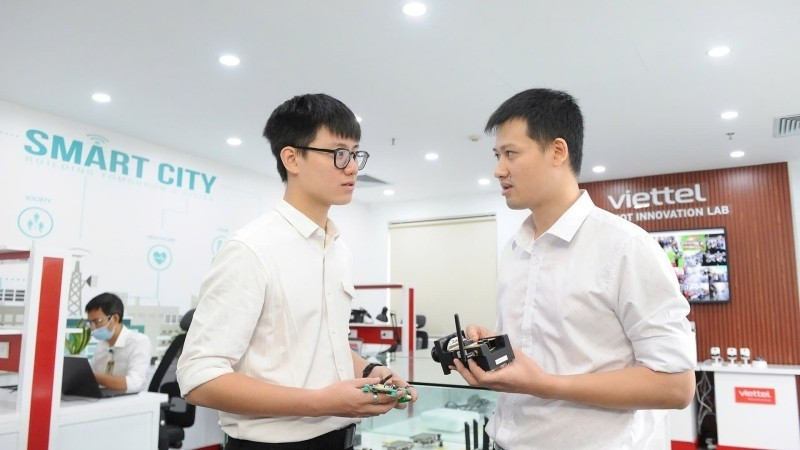Turning point in talent attraction policy
New mechanisms and policies, especially the Law on Science, Technology and Innovation and the Law on Digital Technology Industry, are expected to create an environment to truly attract, retain, and maximise the potential of talented individuals, thereby bringing strategic breakthroughs to Viet Nam’s spearhead technological sectors.

Legalise the meritocracy
One of the core contents of the Law on Science, Technology and Innovation is to recognise and grant greater rights to scientists, including intellectual property rights, commercial exploitation of research results, and financial use autonomy. The law also stipulates that the state has special preferential policies for talents in the fields of science, technology and innovation through financial and non-financial incentives, favourable working conditions, and housing arrangements. The state creates long-term career development opportunities, attract talents from abroad, and ensure social welfare for talents and their families.
Moreover, the Law on Digital Technology Industry, issued in June 2025, affirms the role of this sector as a spearhead economy, playing a role of a momentum of growth and innovation. The law focuses on the development of the semiconductor industry, the artificial intelligence ecosystem, and digital assets, with outstanding preferential policies dedicated specifically to enterprises and experts in these fields.
According to the Ministry of Science and Technology, after the issue of these new laws, detailed decrees and circulars will be needed to guide the implementation of talent attraction measures. At the same time, provisions must be harmonised with other laws such as the Law on State Budget and the Law on Public Employees, avoiding excessive procedures and inflexible regulations.
Financial support for scientists in Viet Nam is still not competitive compared to developed countries; working environments, facilities, academic culture and career development opportunities all need comprehensive improvement to attract and retain the talents. Although the new laws open possibilities for “out-of-frame” salaries, bonuses, and allowances, these remain principles on paper. Therefore, mechanisms must be concretised in guiding documents to ensure effective implementation in practice.
Need a team of top scientists
During a recent meeting with the Viet Nam Academy of Science and Technology, Deputy Prime Minister Nguyen Chi Dung emphasised that many highly qualified and well-trained experts and scientists are working in leading universities, research institutes and technology enterprises in developed countries. Notably, many young Vietnamese scientists who studied abroad have returned to the homeland to work, making effective contributions to many fields.
However, the Deputy Prime Minister urged the implementation of comprehensive solutions, including building a professional, dynamic research environment, ensuring favourable working conditions, appropriate treatment mechanisms and long-term career opportunities to better attract Vietnamese scientists abroad.
Recently, General Secretary To Lam directed the Ministry of Home Affairs, in coordination with the Ministry of Science and Technology and other relevant ministries and sectors, to urgently build and issue special preferential policies to attract at least 100 leading experts to return to work in Viet Nam. At the same time, the Ministry of Science and Technology has been assigned to implement the Talent Attraction Strategy until 2030, with a vision to 2050, to be completed by September 2025.
In the context of Resolution No. 57-NQ/TW identifying science, technology, and innovation as fundamental and essential drivers of the national development in the new period, and the list of 11 strategic technology groups approved by the Prime Minister under Decision No. 1311/QD-TTg in June 2025, the demand for technological talent and “chief architects” is becoming increasingly urgent.
When mentioning the implementation of space technology research, Dr. Nguyen Quan, former Minister of Science and Technology, noted that apart from the state’s investment and enterprises’ participation, it needs to pay particular attention to attract good scientists, contributing to the goal of turning Viet Nam into a high-income developed nation by 2045.
“We can discuss about policies, resources and capital resources that the state is willing to provide for scientific research projects, but without granting freedom to researchers and scientists to explore, development will be limited. The biggest challenge for Viet Nam is management; if we can create an open and favourable environment, it will attract talent from abroad to contribute to the country’s science, technology and innovation,” shared Dr. Nguyen Trong Hien, a specialist at the US National Aeronautics and Space Administration (NASA).
Enterprises are also awaiting concrete policies to effectively implement the attraction of high-quality human resources. A representative of Viettel Group said that the state needs to have more consistent and effective mechanisms such as housing support, income tax incentives, and allowing experts to own or co-own research results, inventions, and patents, as well as to hold shares in enterprises established from research results.
To implement the mission of issuing special preferential mechanisms and policies to attract leading experts to return the country, the Ministry of Science and Technology is building detailed policies in line with Resolution No. 57-NQ/TW; completing the project on talent and high quality human resource development and utilisation, along with programmes on drawing Vietnamese scientists abroad back home through special financial support, excellent research conditions, and career development opportunities.
At the same time, it is necessary to invest in upgrading research infrastructure, building centres that meet international standards, and establishing high-tech zones and technology incubators to create a favourable environment for creativity and innovation. Administrative barriers will be reduced, autonomy expanded, and sufficient resources provided to ensure technological research and testing. Evaluation mechanisms for research process will also shift strongly towards output-based results (international publications, patents, commercialised products, etc.).








